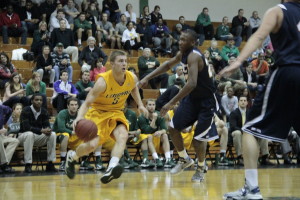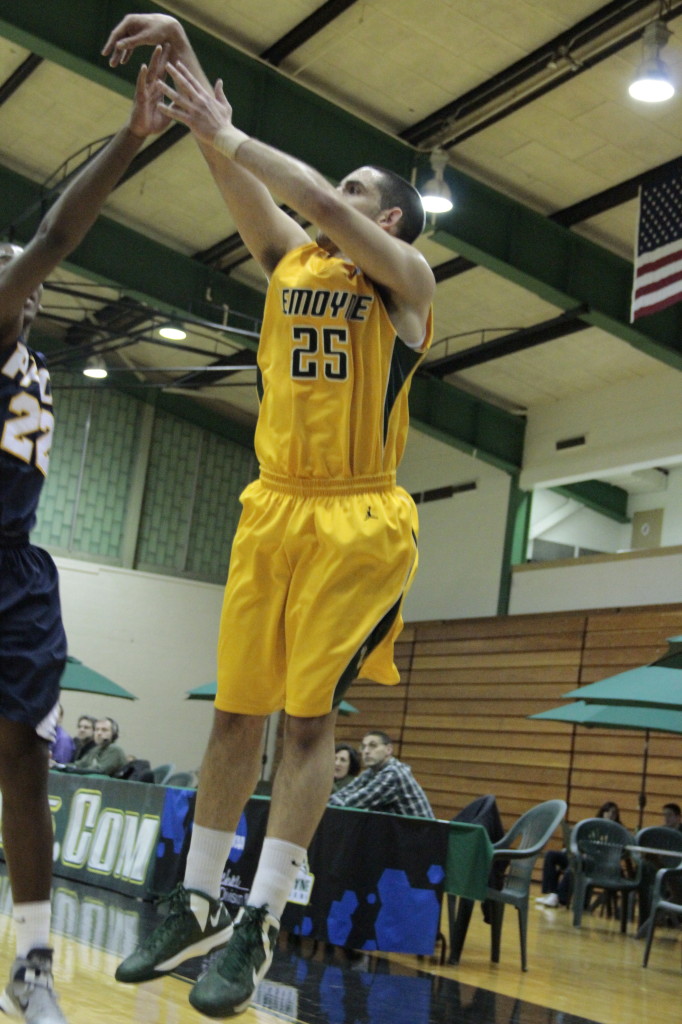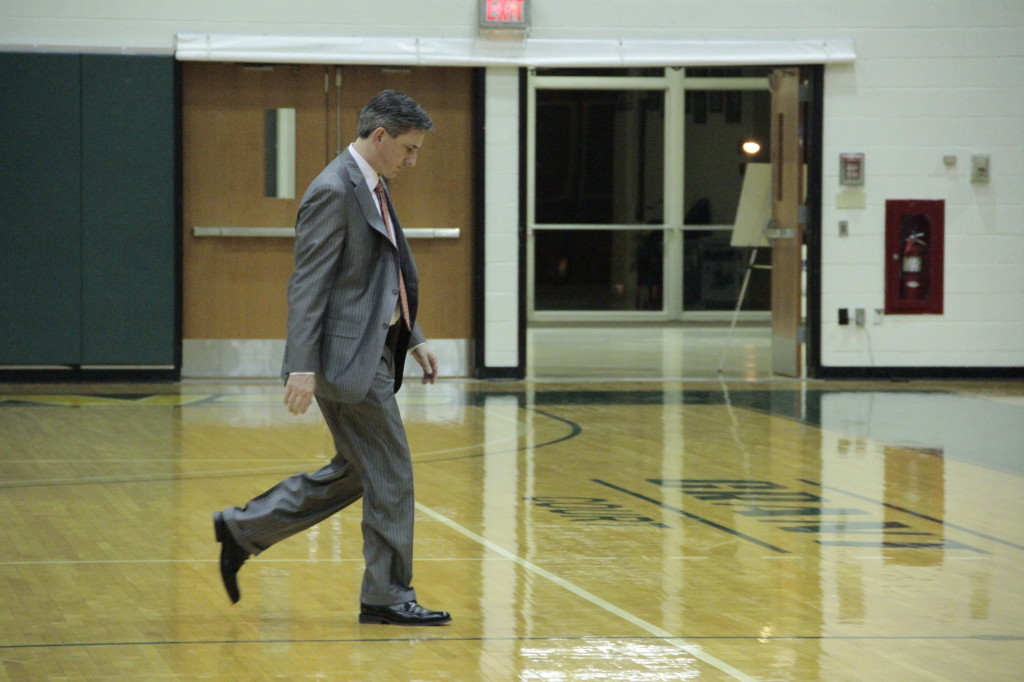Editor’s note: Every basketball season, the Syracuse University Orange captures the attention of fans in its quest to reach the Final Four. But across town is another group of athletes working just as hard. Reporter Stephen Cohen spent some time with the Dolphins in the spring.
In April, millions of people watched the NCAA Division I Men’s Basketball National Championship, either for the fate of their favorite side or, more likely, their office bracket pool. The basketball games in the national tournament played by young men barely through adolescence are an annual rite of spring and pop culture phenomenon, not to mention big business.
But most of the nation’s college athletes never feel the adulation of the masses, see their faces beaming out from the television or command a room during a national news conference, reporters hanging on every word.
And their careers matter every bit as much as the careers of the big boys.
Take Nate Champion. On an afternoon in late February, he was alone in the gym at Le Moyne College’s Henninger Athletic Center. Practice didn’t start for a half-hour, but Champion was already hard at work. He dribbled the ball from his left hand to his right, staring down invisible defenders before driving to the lane, stopping suddenly and rising to fire off a fadeaway jumper that hit nothing but net. He grabbed his own rebound, jogged back to the top of the key and did it all again. By himself.
Thirty minutes later, Champion and 11 of his teammates crammed the office of LeMoyne head coach Steve Evans, where Evans waited with assistant Mike Smiley and grad assistant Zach Tomsen. It was a tight fit. Three lanky bodies on the couch, two more perched on the coffee table, a few more on folding chairs and the rest on the floor, all staring at the television mounted on the wall in front of them.
Evans played back game tape from the Division II Dolphins’ last contest, and the conversation in the room began to sound like a foreign language.
“Dribble the wing-through means fist action,” said Smiley, standing along the bookshelf behind Evans’ desk. “These fours and fives are just trying to sniff out a duck-in in the caves.”
They watched highlights of the next night’s opponent, Pace University. The last regular season game of the year was an important one for the Dolphins, who needed the win to assure their place in the ultra-competitive Northeast-10 Conference tournament. For four of the Dolphins, it had potential to be the last basketball game of their careers.
The Final Four-bound SU team plays about three miles away from Evans’ office. While technically a collegiate program in the same fashion as LeMoyne, the Orange dominate the area as the region’s de facto professional franchise. Two days earlier, Syracuse hosted Georgetown in front of more than 35,000 fans in the Carrier Dome, the largest on-campus crowd in NCAA history. They generate millions in revenue, perpetually send players to the NBA and they’re fronted by the region’s most recognizable coach, Jim Boeheim.
In the billion-dollar industry that is intercollegiate athletics, the term “student-athlete” is usually punctuated with a wink. But at Le Moyne, it doesn’t ring hollow. Here, the lessons learned over four years of sacrifice mean every bit as much as the final score. Sometimes even more.
Nate Champion learned perseverance the hard way this year. After what Evans called a “terrific sophomore year,” he had all-league hopes for his junior guard from Logansport, Ind. But Champion’s knee was injured, requiring offseason surgery and sidelining him for almost six months. When he was nearly recovered, he tangled his hand in a teammate’s jersey in practice and hurt a finger, which took him out of action again. After Christmas break, he caught the flu, then sprained an ankle. Coming into that final game against Pace, he’d just started to play up to his potential.
The season had been a nightmare, and at any point he could have quit. Chalk it up to bad luck and try again next year. But there he was before practice, working on his own, as if the team were counting on him for a championship run.
“I hold myself accountable to be the best I can be,” says Champion. “I’m not going to waste anybody else’s time being subpar. I just always want to work as hard as I can and grow, work on weaknesses before and after practice.”
Even if his effort to come back didn’t make local headlines, let alone national ones, it’s noticed by the people who matter most.
“Nate’s always been a fierce competitor,” says his father, Bill. “What he did the last week or two of this season impressed me more than anything he’s done since he’s been there, the fact that he had to come back from some adversity, found a way to get back in the lineup and contribute.”
Champion’s dedication to improving his game didn’t surprise senior captain Gamal Mohamed. “Nate is always on top of making sure he’s putting in the extra effort on the basketball court,” he says, “and I respect that a lot.”
“Extra effort” might as well be Mohamed’s nickname. And over his career at Le Moyne, he’s learned how far hard work and commitment can take him. After an accomplished high school career in New Jersey, Mohamed signed with the Dolphins after a prom-night introductory phone call from Evans. He’s never been the most talented player on the floor, but Mohamed developed into the heart and soul of the Le Moyne team.
“I’m not stupid,” he says. “If I know I’m not the most physically gifted, not the most talented, I’m going to do other things because I want to play. I haven’t always been the go-to guy, but year by year I’ve inched my way up into spots where I’m playing major minutes because of my work ethic and my discipline. I always say I’m on the court because of how smart I am, not how good I am.”
He displayed his drive away from the gym, as well.
“He’s always loved basketball, so it was his dream to continue after high school and play in college,” says Mohamed’s mother, Patricia. “But it was hard. He’d tell us about the travel and practices and trying to get schoolwork done, but he’s been on the dean’s list the whole time he’s been there. I’m so proud of him. I don’t know how he did it.”
For his coach, Mohamed functioned as an on-court object lesson. “I couldn’t be prouder of him,” says Evans. “All he did was bust his butt every day. He has taken to the identity and the culture we’re trying to establish to be a consistent performer in the top of this league.”
The whole team busted their butts in that late-February practice, every drill humming with intensity and effort. Maybe it was because they were playing their last game of the regular season. Maybe it was because there was a reporter in the gym. The Dolphins aren’t used to a lot of press attention.
They’re not used to a lot of the amenities larger programs enjoy, either. Forget charter flights for road trips. Forget any flights, for that matter. The Dolphins bus to away games, and the fact that Le Moyne is the westernmost school in the Northeast-10 presents some challenges. Returning to school at 2 a.m. only to have to wake up for early-morning classes is just part of the deal. There’s no preferential treatment for athletes here, where 75 percent of students participate in some type of athletics. It’s part of the culture.
“You don’t want to let anybody down, so you do your best to be successful,” says Champion. “That goes for the classroom, too. Teachers are going to be holding you accountable to get your assignments done whether you’re on the road or not. They’re not going to hold the class up just to wait for you.”
Nothing is handed to the players here. There are no “one-and-dones,” and no one is majoring in basketball. The students here are forced to be well-rounded, indicative of the Division II motto, “Life in the Balance,” and it’s part of what makes this level of athletics distinctive.
“Is it a little bit different than Division I?” asks Le Moyne athletic director Matt Bassett. “It’s a lot different than Division I. It doesn’t take away the coaches’ or players’ desire to be more successful on the scoreboard, but we do understand and value all the other things that are good and right about being an intercollegiate athlete. What it allows us to do is enjoy the process of watching our young people grow up in front of our eyes.”
Wins and losses still matter a great deal to Evans. He is a coach, after all. But sometimes the connections with current and former players, the stories of what they learned or who they became under his tutelage grant him a reprieve from the grind.
“The games all start washing in and out through the years,” he says. “You remember the losses probably a lot more than the wins, unfortunately. So it’s nice to have these stories, the real reasons why this is a rewarding profession, because the season itself can absolutely tear you apart.”
The 2012-2013 campaign lasted only a couple more games after that late-February practice. Continuing their strong effort from the night before, the Dolphins destroyed Pace 83-52 in a game that wasn’t even as close as the scoreboard indicated. But they lost their first game of the Northeast-10 tournament at University of Massachusetts Lowell, ending their season, along with Mohamed’s career.
“I’ve been playing the game since I was 6,” he says, “and it’s over in a heartbeat. Now that I look back, it went by in the blink of an eye. I miss it terribly already.”
The lessons Mohamed learned here now start carrying over to life after basketball, and that’s the point, according to his coach.
“I’d like to think it’s more about the game of life than the game of basketball,” says Evans. “My message as a teacher is to use the lessons they learn in athletics to carry over to other areas, socially, academically, spiritually, whatever it is in life, to be better and push yourself. Hopefully those are things that pay dividends down the road.”
If Champion and Mohamed are any indication, the message is already getting through.
“Take advantage of the opportunities you’re given,” says Champion, resolved to make the most of his remaining year of eligibility.
As for Mohamed, he prepared to take the MCAT in the summer, then applied to medical school. He believes his experiences at Le Moyne have prepared him for the next steps.
“I feel like that’s going to help me a ton,” he says, “because nothing can hold me back now.”
_________________________________________________________________________________________
Steve Evans: Stalking the Sideline
Steve Evans has always been around the game, the son and grandson of coaches. His father, Stan “Buddy” Evans, was a legendary coach for Rome Free Academy, inducted into the New York State Basketball Hall of Fame in 2011. But Buddy didn’t see his son taking over the family business.
“I didn’t really expect him to get into coaching,” says Buddy, “but as a father, I’m very pleased and happy he did. I think any father who’s in business or in a teaching profession would like to have his son follow in his footsteps.” After ending his playing career at Union College, in Schenectady, Steve’s first coaching position was at Le Moyne College, where he served as a graduate assistant for two seasons. He then went to the Division I ranks, assisting at Sienna and Northwestern before being offered the head job at Le Moyne. To fans accustomed to the win-at-all-costs culture of sports, Evans’ tenure at Le Moyne might seem puzzling. In 13 years, he’s compiled a record that’s under .500 and never qualified for an NCAA tournament selection. But this is Division II, and coaches here are judged on more than just their record. “Sure, he wants to win more,” says athletics director Matt Bassett. “I’m sure his players want to win more. We all want them to win more. But there’s more of a comprehensive review of the experiences that these young people are afforded in his program. And all of those other things that happen are things that we value here.” Evans has established a home in Syracuse with his wife, Michelle, and son, Trey, 8. And if Trey’s enthusiasm is any indication, they might well have another coach in the family. “He loves it,” says Michelle. “He follows it. Whenever anybody asks me any questions, I’m like, ‘Just ask Trey. He can give you the scouting report.’”











